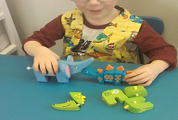Using construction puzzles to introduce whole-part relationships



When we first started this activity, the parts of the animals were assembled in total disarray. While the child was able to match the colors, the sizes of the pieces were not in order to show that the dinosaur had an arch to his back, the legs of the alligator were assembled upside down, and the elephant did not have a belly. Instead two leg sections had been assembled together.
Whole-part relationships evolve from visual perceptual skills of discrimination. Concepts such as awareness of details in color, size, distance, shape, spatial position are commonly referred to as visual discrimination skills. For the developing child, the ability to differentiate among details grows with language skills, to the point where they become intermingled.. As the features that differentiate among various objects are viewed, internal questions are posed, namely “What is this and what is it part of?”
For example, lets look at the large puzzle piece the girl is holding.

Can you see that the puzzle piece contains the shape of an angle that comes together in front of a blue background with wisps of white near the top with a straight edge? Because of the colors, their position near the top, and the shape formed by the angle, whole-part relationships might suggest that this might be the peak of a rooftop.

Now, look at the smaller jigsaw puzzle when it is partially assembled. Can you see the resemblance?
Whole-part relationships function to aid efficiency as we interpret sensory input. In the instances of visual processing skills, whole-part relationships can serve protective functions. For example, as we notice differences between the height of a street and the sidewalk, we may be prompted to adjust our steps to lift up our feet as we mount the curb. As we look at a sidewalk and immediately notice differences in the outline of the sidewalk, these differences might reveal a crack to be stepped over. In a similar manner, when driving a car or riding a bicycle on a street, differences in the road surface might indicate the presence of a pothole.
At other times, various types of visual-whole part relationships aid efficiency in daily living skills, such as when looking for matching clothing that goes together in terms of color, finding a screwdriver tip that matches a screw, putting a shoe on the foot that matches, putting hamburgers and hotdogs into buns shaped to fit.
Whole-part relationships develop to aid in problem solving skills across functional domains. In school, these relationships help us to understand math operations. While at home, whole-part relationships aid us problem solve daily living skills.

Comments are closed.